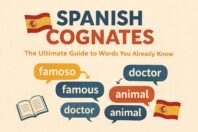How to Introduce Yourself in Spanish: Essential Spanish Introductions and Responses

Get our free email course, Shortcut to Conversational.
Have conversations faster, understand people when they speak fast, and other tested tips to learn faster.
More infoAs beginners, we know that one of the very first things we want to learn when it comes to languages is how to introduce ourselves. Not only because that is the first impression people are going to have from us, but also because it can result in a nice relationship. You have several options for how to introduce yourself in Spanish.
That is why in this article we will go through different ways to let people know basic information about us depending if we are involved in a formal or informal situation, we will also learn how to ask for someone else’s information and how to introduce somebody else.
Let’s dive in.
Introducing yourself
Let’s start with the basics on how to present yourself to someone new. First we’ll give you some informal introductions, and then go into how to introduce yourself in Spanish in situations where a higher level of formality is necessary.
Informal introductions: ¡Hola!, ¿Qué tal?
When you’re at a bar or a friend’s house and you’re introducing yourself to the other people there, a simple ¡Hola! or ¿Qué tal? is a good informal starting point, which basically translate to Hey! or What’s up?. Check out our other post for a good explanation on qué tal vs cómo estás.
Once you’ve said hello, you have a few choices on how to say who you are.
Mi nombre es … – My name is …
This one is pretty straightforward, with a straight translation between English and Spanish.
- ¡Hola! Mi nombre es Eddy, ¿Cómo te llamas? – Hi! My name is Eddy. What is your name?
Me llamo … – My name is …
This is the other phrase for saying what someone is named, though the translation is closer to “I am called.” Llamarse is a reflexive verb, so, as we saw in the previous example, the reflexive pronoun changes depending on who’s being named.
- ¡Hola! Me llamo Ana. ¿Cómo estás? – Hello! My name is Ana, how are you?
Soy … – I’m …
This one is about as informal as you can get. It’s a straight translation of the English I’m, using the Spanish verb ser.
- ¿Qué tal? Soy Juan. ¿Cómo están todos? – Hi there! I’m Juan, how’s everyone?
More formal: Buenos Días, Buenas Tardes, Buenas Noches
In more formal contexts, it’s best to avoid greetings like ¡Hola! Whether you’re meeting someone new at work, at a professional conference, or in an academic environment, you’re better off starting with these greetings wishing them a good day, afternoon, or evening: Buenos días, Buenas tardes, Buenas noches. Note that though all three are normally used in plural, sometimes the first is also used in singular: Buen día.
Once we’ve said our formal greeting, the three choices on how to introduce yourself in Spanish we saw above can still follow:
- Buenos días a todos, mi nombre es Steve y yo voy a ser su nuevo profesor. – Good morning everyone, my name is Steve and I am going to be your new teacher.
- Buenas tardes, soy Antonio Gerrero y estoy aquí para la entrevista de trabajo. – Good afternoon, I am Antonio Guerrero, and I am here for the job interview.
- Buenas noches y bienvenidos al taller, me llamo Alexander y seré su instructor. – Good evening and welcome to the workshop, my name is Alexander and I will be your instructor.
Responding to introductions
Once one person introduces themself, there are some standard responses to say we’re pleased to meet them.
Mucho gusto, Un gusto
These short phrases are literally translated as Much pleasure and A pleasure, but a more accurate equivalent is nice to meet you. They can be used in both formal and informal situations. Those are nice ways to respond when someone has already introduced themselves to us.
- ¡Hola! Mi nombre es Andrés. / Mucho gusto, Andrés. Soy Mario. – Hello! My name is Andrés. / Nice to meet you, Andrés. I’m Mario.
[Es] Un placer conocerte / conocerlo, [Es] Un gusto conocerte / conocerlo
These two phrases have the same meaning, that it’s a pleasure to meet you. Both un placer and un gusto translate as a pleasure. The initial es – it’s in this phrase is optional.
The Spanish verb conocer is similar to the English verb to know someone, and it’s used with the direct object pronouns depending on who you’re speaking to. In familiar situations, you can use te, while if you’d address someone with usted then you’ll use lo or la.
- ¡Hola Ana, un gusto concerte! – Hi Ana, it’s a pleasure to meet you!
- Buenos días, Sra. Ramírez. Es un placer conocerla. – Good morning Mrs. Ramírez, it’s a pleasure to meet you.
El placer es mío, El gusto es mío
These phrases are actually responses to the previous two, meaning the pleasure is mine. Just be sure to use the same word for a pleasure as was used first, whether el placer or el gusto:
- Es un placer conocerla, Sra. Ramírez. / El placer es mío, Señor.
- Mucho gusto, Rachel. / El gusto es mío, Michael. – Nice to meet you, Rachel. / The pleasure is mine, Michael.
[Estoy] Encantado de conocerte / conocerlo
This phrase is a bit more formal than our previous ones, though it can still be used in any context. It translates as I’m delighted to meet you.
It’s built around the adjective encantado, which means delighted. Remember that since it’s an adjective, the ending needs to match the gender of the person speaking.
As in our previous phrases, the initial estoy – I’m is optional. In fact, for a quick response we can even drop the latter part of the phrase too and just say Encantado.
- ¿Qué tal? Soy Jack. / Encantada. Mi nombre es Michelle. – What’s up? I’m Jack. / Delighted [to meet you]. My name’s Michelle.
- Buen día, me llamo Anita Esteban. / Estoy encantado de conocerla. Soy Pablo Hernandez. – Good morning, my name is Anita Esteban. / I’m delighted to meet you. I’m Pablo Hernandez.
Asking someone to introduce themself in Spanish
So far we’ve focused on how to introduce yourself in Spanish, but what if you want to prompt someone else to introduce themself? Here we’ll introduce the basic questions for asking someone’s name.
¿Cómo te llamas? – ¿Cómo se llama?
This is the classic question for asking someone’s name. As we saw earlier, the literal translation is closer to “how are you called?”, though it’s understood that we’re asking “what’s your name?”
Since llamarse is a reflexive verb, the level of formality is reflected through the choice of indirect pronoun. We use se when addressing someone with whom we’d use usted, while se can also be used with a third person to ask their name.
- Hola! Soy Antonio. ¿Cómo te llamas? – Hey, I’m Antonio. What’s your name?
- Buenos días, disculpe. ¿Cómo se llama? / Buen día, soy el Sr. Goulding. Mucho gusto. – Good morning, excuse me. What is your name? / Good morning, I’m Mr. Goulding. Nice to meet you.
- Tu compañera de casa es tan linda. ¿Cómo se llama? – Your housemate is so cute. What’s her name?
¿Cuál es tu nombre? – ¿Cuál es su nombre?
Here’s the other option for how to say “what is your name?” in Spanish, which relates to the first way we saw earlier for how to introduce yourself in Spanish. The direct translation of “¿cuál es tu nombre?” is “what is your name.” We respect the level of formality by changing the possessive adjective, which is also how we can ask the name of a third person.
- ¡Hola! ¿Cuál es tu nombre? / Mi nombre es Lucía. ¿Cuál es el tuyo? – Hi there! What’s your name? / My name is Lucía, what’s yours?
- Buenas tardes señor. ¿Cuál es su nombre? / Buenas tardes. Mi nombre es Rodrigo Diaz. – Good afternoon, sir. What is your name? / Good afternoon. My name is Rodrigo Diaz.
- Tu perro es muy amable. Cual es su nombre? – Your dog is so friendly. What is its name?
Introducing Someone Else
The last form of presentations we need is how to introduce someone else in Spanish. The first introduction is simply to say “Quiero presentarte a …”, meaning “I want to introduce … to you”.
Then, like we saw in the first section, we have the choice between saying that “their name is …” or simply “they are …”. Let’s see a few examples:
- Quiero presentarte a mi hija. Ella se llama Lucía. – I want to introduce you to my daughter. Her name is Lucía.
- ¡Hola Kim! Quiero presentarte a mi novio. Su nombre es Justin. – Hey Kim!, I want to introduce you to my boyfriend. His name is Justin.
- Ellos son Mario y Carmen, mis primos. – They are Mario and Carmen, my cousins.
- His name is Diego, he is going to college too. – Él se llama Diego, él también va a la universidad.
Conclusion
There you have it. We’ve just gone over the full variety of introductions in Spanish. We started with how to introduce yourself in Spanish, using either me llamo or mi nombre es to state your name. We saw a handful of standard responses, namely mucho gusto, encantado, and es un placer conocerte. We learned the questions to ask someone else to introduce themself, again using either the verb llamarse or directly asking their nombre. And finally, we learned how to introduce someone else, starting with quiero presentarte a …
Hopefully you found these to all be fairly straightforward, so you’re ready to meet new people and feel confident with your introductions in Spanish. ¡Mucho gusto!



